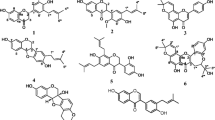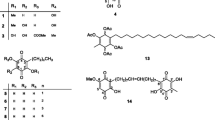Summary
Introduction Multidrug resistance in cancer represents a major problem in chemotherapy. The present study was designed to assess the cytotoxicity of anthraquinones from Pentas schimperi, namely damnacanthal (1), damnacanthol (2), 3-hydroxy-2-hydroxymethyl anthraquinone (3) and schimperiquinone B (4) against nine drug-sensitive and multidrug resistant (MDR) cancer cell lines. Methods The resazurin reduction assay was used to evaluate the cytotoxicity of the above compounds, whilst caspase-Glo assay was used to detect the activation of caspases enzymes by compounds 1 and 2. Cell cycle, mitochondrial membrane potential (MMP) and levels of reactive oxygen species were all analyzed via flow cytometry. Results Anthraquinones 1 and 2 displayed cytotoxic effects with IC50 values below 81 μM on all the nine tested cancer cell lines whilst 3 and 4 displayed selective activities. The recorded IC50 values for compounds 1 and 2 ranged from 3.12 μM and 12.18 μM (towards leukemia CCRF-CEM cells) and from 30.32 μM and 80.11 μM (towards gliobastoma U87MG.ΔEGFR cells) respectively, and from 0.20 μM (against CCRF-CEM cells) to 195.12 μM (against CEM/ADR5000 cells) for doxorubicin. Compounds 1 and 2 induced apoptosis in CCRF-CEM leukemia cells, mediated by the disruption of the MMP and increase in ROS production. Conclusions Anthraquinones from Pentas schimperi and mostly 1 and 2 are potential cytotoxic natural products that deserve more investigations to develop novel antineoplastic drugs against multifactorial drug resistant cancers.





Similar content being viewed by others
References
Shen B, Li D, Dong P, Gao S (2011) Expression of ABC transporters is an unfavorable prognostic factor in laryngeal squamous cell carcinoma. Ann Otol Rhinol Laryngol 120:820–827
Biedler JL, Spengler BA (1994) Reverse transformation of multidrug-resistant cells. Cancer Metastasis Rev 13:191–207
Efferth T, Sauerbrey A, Olbrich A, Gebhart E, Rauch P, Weber HO, Hengstler JG, Halatsch ME, Volm M, Tew KD, Ross DD, Funk JO (2003) Molecular modes of action of artesunate in tumor cell lines. Mol Pharmacol 64:382–394
Efferth T, Sauerbrey A, Halatsch ME, Ross DD, Gebhart E (2003) Molecular modes of action of cephalotaxine and homoharringtonine from the coniferous tree Cephalotaxus hainanensis in human tumor cell lines. Naunyn Schmiedebergs Arch Pharmacol 367:56–67
el-Deiry WS (1997) Role of oncogenes in resistance and killing by cancer therapeutic agents. Curr Opin Oncol 9:79–87
Kuete V (2013) Medicinal Plant Research in Africa. In: Kuete V (ed) Pharmacology and Chemistry, 1st edn. Elsevier, Oxford
Dave H, Ledwani L (2012) A review on anthraquinones isolated from Cassia species and their applications. Indian J Nat Prod Res 3:291–319
Eyong KO, Kuete V, Efferth T (2013) 10 - Quinones and Benzophenones from the Medicinal Plants of Africa. In: Kuete V (ed) Medicinal Plant Research in Africa. Elsevier, Oxford, pp 351–391
Kimmig A, Gekeler V, Neumann M, Frese G, Handgretinger R, Kardos G, Diddens H, Niethammer D (1990) Susceptibility of multidrug-resistant human leukemia cell lines to human interleukin 2-activated killer cells. Cancer Res 50:6793–6799
Gillet J, Efferth T, Steinbach D, Hamels J, de Longueville F, Bertholet V, Remacle J (2004) Microarray-based detection of multidrug resistance in human tumor cells by expression profiling of ATP-binding cassette transporter genes. Cancer Res 64:8987–8993
Doyle LA, Yang W, Abruzzo LV, Krogmann T, Gao Y, Rishi AK, Ross DD (1998) A multidrug resistance transporter from human MCF-7 breast cancer cells. Proc Natl Acad Sci U S A 95:15665–15670
Kuete V, Tchakam PD, Wiench B, Ngameni B, Wabo HK, Tala MF, Moungang ML, Ngadjui BT, Murayama T, Efferth T (2013) Cytotoxicity and modes of action of four naturally occuring benzophenones: 2,2′,5,6′-tetrahydroxybenzophenone, guttiferone E, isogarcinol and isoxanthochymol. Phytomedicine 20:528–536
Kuete V, Sandjo L, Nantchouang Ouete J, Fouotsa H, Wiench B, Efferth T (2013) Cytotoxicity and modes of action of three naturally occuring xanthones (8-hydroxycudraxanthone G, morusignin I and cudraxanthone I) against sensitive and multidrug-resistant cancer cell lines. Phytomedicine 21:315–322
Kuete V, Sandjo L, Wiench B, Efferth T (2013) Cytotoxicity and modes of action of four Cameroonian dietary spices ethno-medically used to treat Cancers: Echinops giganteus, Xylopia aethiopica, Imperata cylindrica and Piper capense. J Ethnopharmacol 149:245–253
O’Brien J, Wilson I, Orton T, Pognan F (2000) Investigation of the Alamar Blue (resazurin) fluorescent dye for the assessment of mammalian cell cytotoxicity. Eur J Biochem 267:5421–5426
Kuete V, Fankam AG, Wiench B, Efferth T (2013) Cytotoxicity and Modes of Action of the Methanol Extracts of Six Cameroonian Medicinal Plants against Multidrug-Resistant Tumor Cells. Evid Based Complement Alternat Med 2013:285903
Kuete V, Tankeo SB, Saeed ME, Wiench B, Tane P, Efferth T (2014) Cytotoxicity and modes of action of five Cameroonian medicinal plants against multi-factorial drug resistance of tumor cells. J Ethnopharmacol 153:207–219
Bass DA, Parce JW, Dechatelet LR, Szejda P, Seeds MC, Thomas M (1983) Flow cytometric studies of oxidative product formation by neutrophils: a graded response to membrane stimulation. J Immunol 130:1910–1917
Cossarizza A, Ferraresi R, Troiano L, Roat E, Gibellini L, Bertoncelli L, Nasi M, Pinti M (2009) Simultaneous analysis of reactive oxygen species and reduced glutathione content in living cells by polychromatic flow cytometry. Nat Protoc 4:1790–1797
Endale M, Ekberg A, Alao JP, Akala HM, Ndakala A, Sunnerhagen P, Erdelyi M, Yenesew A (2012) Anthraquinones of the roots of Pentas micrantha. Molecules 18:311–321
Guido R, Menavanza N, Kurt H (1995) Anthraquinones from Morinda lucida. Int J Pharmacogn 33:107–114
Donfack A, Tala M, Wabo H, Jerz G, Zeng G-Z, Winterhalter P, Tan N-H, Tane P (2014) Two new anthraquinone dimers from the stem bark of Pentas schimperi (Rubiaceae). Phytochemistry Lett 8:55–58
Kuete V, Sandjo LP, Djeussi DE, Zeino M, Kwamou GM, Ngadjui B, Efferth T (2014) Cytotoxic flavonoids and isoflavonoids from Erythrina sigmoidea towards multi-factorial drug resistant cancer cells. Invest New Drugs 32:1053–1062
Boik J (2001) Natural compounds in cancer therapy. Oregon Medical Press, Minnesota USA
Brahemi G, Kona FR, Fiasella A, Buac D, Soukupova J, Brancale A, Burger AM, Westwell AD (2010) Exploring the structural requirements for inhibition of the ubiquitin E3 ligase breast cancer associated protein 2 (BCA2) as a treatment for breast cancer. J Med Chem 53:2757–2765
Kuete V, Efferth T (2015) African flora has the potential to fight multidrug resistance of cancer. BioMed Res Int 2015:914813
Thani W, Vallisuta O, Siripong P, Ruangwises N (2010) Anti-proliferative and antioxidative activities of Thai noni/Yor (Morinda citrifolia Linn.) leaf extract. Southeast Asian J Trop Med Public Health 41:482–489
Abu N, Ali NM, Ho WY, Yeap SK, Aziz MY, Alitheen NB (2014) Damnacanthal: a promising compound as a medicinal anthraquinone. Anticancer Agents Med Chem 14:750–755
Aziz MY, Omar AR, Subramani T, Yeap SK, Ho WY, Ismail NH, Ahmad S, Alitheen NB (2014) Damnacanthal is a potent inducer of apoptosis with anticancer activity by stimulating p53 and p21 genes in MCF-7 breast cancer cells. Oncol Lett 7(5):1479–1484
Dibwe DF, Awale S, Kadota S, Tezuka Y (2012) Damnacanthal from the Congolese medicinal plant Garcinia huillensis has a potent preferential cytotoxicity against human pancreatic cancer PANC-1 cells. Phytother Res 26:1920–1926
Alnemri ES, Livingston DJ, Nicholson DW, Salvesen G, Thornberry NA, Wong WW, Yuan J (1996) Human ICE/CED-3 protease nomenclature. Cell 87:171
Patterson LH (1993) Rationale for the use of aliphatic N-oxides of cytotoxic anthraquinones as prodrug DNA binding agents: a new class of bioreductive agent. Cancer Metastasis Rev 12:119–134
Wu W, Yan R, Yao M, Zhan Y, Wang Y (1996) Pharmacokinetics of anthraquinones in rat plasma after oral administration of a rhubarb extract. Biomed Chromatogr 28:564–572
Ma YS, Weng SW, Lin MW, Lu CC, Chiang JH, Yang JS, Lai KC, Lin JP, Tang NY, Lin JG, Chung JG (2012) Antitumor effects of emodin on LS1034 human colon cancer cells in vitro and in vivo: roles of apoptotic cell death and LS1034 tumor xenografts model. Food Chem Toxicol 2012(50):1271–1278
Acknowledgments
Authors acknowledge the Cameroon National Herbarium (Yaoundé) for the plant identification. VK is very grateful to the Alexander von Humboldt Foundation for an 18 months’ fellowship in Germany through the “Georg Foster Research Fellowship for Experienced Researcher” program. Authors also acknowledge the DAAD for a stipend to MZ.
Conflict of interest
The authors declare that they have no cnflict of interests.
Authors’ contribution
VK and MZ carried out the experiments; VK, ARND and PT contributed to plant’s collection, compound’s isolation and/or identification. VK wrote the manuscript. VK, PT and TE designed the experiments; TE supervised the work, provided the facilities for the study. All authors read the manuscript and approved the final version.
Author information
Authors and Affiliations
Corresponding author
Rights and permissions
About this article
Cite this article
Kuete, V., Donfack, A.R.N., Mbaveng, A.T. et al. Cytotoxicity of anthraquinones from the roots of Pentas schimperi towards multi-factorial drug-resistant cancer cells. Invest New Drugs 33, 861–869 (2015). https://doi.org/10.1007/s10637-015-0268-9
Received:
Accepted:
Published:
Issue Date:
DOI: https://doi.org/10.1007/s10637-015-0268-9




